Wayne C. Allen's Blog, page 17
August 31, 2020
The Relationship Tango
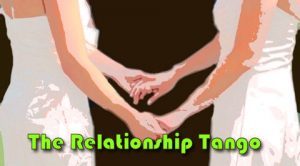
The relationship tango — the purpose of a relationship is the personal growth of both of the people in the relationship. This flies in the face of the romantic notion that relationships are there to get my needs met. Often, people think that what they see in movies or on the soaps is “real.”

Psst!! Hey!!!
Want more great writing designed to help YOU to shift your behaviour?
Want to learn how to find, build or deepen your principal relationship?Want to know more about Zen living and being?Want to learn how to find, build or deepen your principal relationship?
Check out Wayne’s books!!!
Let’s take a look at how our relationships are indicators of our personal development.
You’ll know that Darbella and I think that relating is not about relationships. (There is no such thing as ‘a couple.’ There’s just two individuals who choose how they are going to relate.)
The purpose of a relationship: the best place to encourage personal growth for both of the people in the relationship.
This flies in the face of the romantic notion that relationships are there to get my needs met.
Often, people think that what they see in movies or on the soaps is “real.”
That you find your ‘one true love’ through kismet or karma, that you fall deeply and romantically in love, and ride off into the sunset on the gondola of bliss.
Reality is often much harsher, as is evinced by this “much mentioned but slightly inaccurate statistic: there’s a 50% divorce rate – and that’s just for first marriages. Second marriages actually fare much worse – nearing 75% failure.
Why?
Because people who get divorced the first time do not learn the lesson – do not understand the purpose of a relationship. They think they picked the wrong partner, and that this time they’ll pick better.
So, typically, they marry the opposite of the first schmo (Yiddish – schmuck) and think, “Great! Right partner this time! Now I can really get what I want!”
All they do is end up miserable faster.
They already know a divorce lawyer, so the 2nd one typically ends quicker. Unless they are stubborn.
All relationships start with romance… the hormone driven start of a pairing.
In my book, This Endless Moment, I wrote that hormones are there to get us to breed, and nothing more. The endorphin rush I feel at the first blush of love is nothing more than a drugged state designed to get me to ignore the other person’s true nature long enough to procreate.
This is the reality of all of our relationships, assuming that we started them only on the basis of “love, lust, and hormones.”
Oh sure, we’ll deny that this is what we are doing, but how else to account for the startling realization, some months in, that my partner is not who I thought she or he was?
All of a sudden, I’m noticing flaws. Flaws!!!
We then enter the Conflict stage, and that one we all know. It’s when we try to change our partner, first through wheedling (‘If you loved me, you’d change”) then bartering (‘I’ll do this for you when you do that for me’) then blackmail, threats, fights, separations.
All of this is a result of feeling gypped – I didn’t get what I thought I was getting.
I saw a quote that I wish I’d written down. It was something to the effect that:
My partner is who (s)he is in his or her totality – everything from start to finish.
My partner is not just the last thing he or she did.
Now, this is an interesting thought – and like most things, is paradoxical in nature.
First, fights start because of what is happening right now. On the second hand, it is unusual, when we fight, not to drag in the kitchen sink – all of the other supposed sins of the past. And… on the third hand, my partner may be exhibiting new behaviour. This does not negate the past behaviours. It is added to the past behaviours, creating a richer picture.
Without belabouring the obvious, the fighting stage is a crucial one.
Some people fight forever. I remember counselling one 60-year-old who had been married 40 years. In October, she stated: “My Christmas will be ruined again this year. He won’t hang the lights right.”
I found out:
a) he’d never hung them right
b) she always took that as a sign he didn’t love her
c) she’d berate him and he’d stop talking
d) this had been going on for 40 years AND
e) she’d never once told him how she wanted the lights hung, because “He knows, and hangs them wrong to spite me!”
They’ll go to the grave fighting.
Others, like many of our parents, (before divorce became socially acceptable,) do not fight. They simply live separate lives, sharing the house and the kids, and acting like roommates with privileges. This is the stage of apathy.
Or, you get a divorce, learn nothing, and do it all over again.
The way out, which we’ll look at in detail next week, is dropping the need to be right, letting go of the fighting, and simply getting curious.
So, back to the thread of this article.
The purpose of relationships is to deepen your self-understanding. That’s it. All the rest, including having kids, is secondary. (I’m not denigrating parenting – it’s a biological necessity for the continuation of our species. We could do it without getting married – all that is required is sperm and egg.)
All the ‘stability of the nuclear family’ is so much propaganda – remember the 50% divorce rate? And most of the remaining couples, perhaps 45% are staying out of guilt, fear of failure, or just plain fear. The kids survive anyway.
The purpose of life is not simply to breed and to die. If there is a purpose, it is to deepen our knowing. Relationship is a perfect place (therapist David Schnarch, author of The Passionate Marriage, calls this a crucible) to learn to see myself.

Back before I retired, my clients told me that I was the only person who truly saw and accepted them.
This is both true, and sad.
I see people as they are because I have no wish for them to be other than they are.
And, I encourage everyone to be all that they are – to drag out the scary, juicy, stuck, chargy, dark, horny, happy, depressed parts, and to try them on for size.
I continue to do this without judgement, because I am curious and interested in the totality of their being – not just the politically acceptable parts.
My dance with Darbella is the same. I cannot ever remember wishing to change her, nor have I ever judged her. We have fought a few times in our 38 years together, when both of us got stupid at the same time, but we turned each fight into an exploration, not a battle.
In a sense, we chose to leave conflict behind for co-creativity.
You need to look at your principal relationship, or look at how you are keeping yourself out of one if you don’t have one.

Note: If you are not in a relationship, and want to do a much better job finding a partner that suits you, have a look at my book, Find Your Perfect Partner. You’ll find the tools you need to engage your brain!
I’m not advocating marriage. Many of my friends have principal relationships at a distance, or with friends. The point is, each person need to be in constant contact with at least one person – a dance and dialog where I get called when I get off track.
In my view, it is not sensible to be in a relationship that I am not at least neutral about. If I am angry and judgemental most of the time, why am I there? I need to move on.
If I am at neutral, and my partner and I have (mutually) made a pact of self-exploration (usually with the help of a therapist) I must let go of conflict and choose curiosity. More on this next time.
The reason for dropping conflict and choosing curiosity is simple – conflict steals my energy. I end up railing against my partner, blaming him or her for everything lame and weak, and stupid in my life.
This is altogether too convenient.
Monitor yourself and your gut sense of your principal relationship. You do not have forever, and apathy and lame acceptance is simply that – lame.
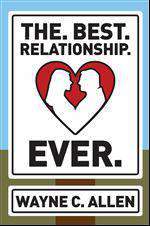
Note: And if your present relationship needs work, well… check out The. Best. Relationship. Ever. It’s my relationships book… you’ll find all the help you need!
August 14, 2020
Nothing is Apparent

Synopsis: Nothing is Apparent to anyone else, and most stuff isn’t even apparent to you!

Psst!! Hey!!!
Want more great writing designed to help YOU to shift your behaviour?
Want to learn how to find, build or deepen your principal relationship?Want to know more about Zen living and being?Want to learn how to find, build or deepen your principal relationship?
Check out Wayne’s books!!!
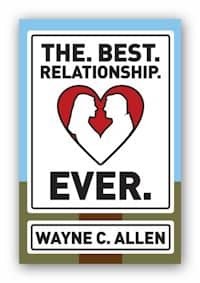
The book most closely associated with this article is The. Best. Relationship. Ever.
One of the biggest mistakes people make when relating is assuming… well… pretty much everything.
Nothing, though, is obvious, and often, what’s “obvious” to you really isn’t, so how on earth could someone else figure out what is unclear to you?
But I was going to write that many people assume that their partner can understand them without assistance. And this is especially so when we get to non-verbal “communication.”
Many are the times when I’ve seen people do stuff like: roll their eyes, or sigh dramatically, or walk away.
Great, just great.
So, what, really, is the message in the eye-roll, or the sigh, and what is meant by abandoning ship and heading off to the bedroom, there to sulk and sigh some more?
Who knows?
Maybe not even you, even when you’re doing it.
I think that the Zen position for life and relating is “I don’t know.” Because I don’t.
Now, I might be dumb enough to think I have answers about you, but even if my guess was right about “you,” it was nothing more than a lucky guess.
One friend slams doors when she’s trying to communicate that she is mad, or is thinking she’s being ignored / neglected, or when she has an agenda and others aren’t cooperating with it–-with her timetable, for example. Those are just three times or situations when door slamming seems, to her, to be appropriate.
Let’s just stick with the obvious for a minute.
How would the person witnessing her “snit” have a clue which of her issues she had set herself off over? “It should be obvious from the context” is not an answer. All the observer knows is that straw person is slamming a door.
It gets even weirder
If her partner does make the mistake of guessing, she then can blame her partner for not guessing correctly! “We’ve been together for [fill in the blank] and if he loved me [properly, according to my definition] he would know!” And, he’s the bad guy because he didn’t read her mind!
Weird, right?
But sadly common. This whole, “It should be obvious” thing comes in many flavours, and I see it and hear about it often, and remember tons of examples from my clients.
The one that I really didn’t get was walking away when in the middle of something.
 There she goes again!
There she goes again!Of course, people would defend themselves by saying, “I was angry [or going to cry, or whatever] so I walked away.” And I’d say, “And after you calmed yourself back down, and came back, did you resolve the issue?”
Blank look. Then, “Well, I was in my room for an hour, and then it was supper time, so I made [ate] dinner, but we [surprise, surprise] never talked about it again.”
Oh, goodie.
What a great plan! Sulk, slink off, make dinner, don’t talk, and then do it all over again the next time. And in the mean time, the relationship stays stuck, and actually sinks a bit into the quicksand of non-direct communication.
I was talking about this with Darbella, and we were grinning over our own dumb strategies. We agreed that the reason for our 38 years of successful communication is our willingness to overlook each others’ games.
To wit: I tend to act like a spoiled 8‑year-old, while Dar defaults to pulling in and curling up in a ball.
Left to our own dumbness, I’d be ranting while she was hiding under something.
Not helpful.
Our “rule” is, it takes one adult. By this we mean that, when one or the other of us pulls something that might take us off topic, it only takes one of us to stop the drift. The few times we’ve had “fights” is when neither of us would stop being an idiot long enough for an “adult” to show up.
My friend needs to stop sulking, slamming, and yelling. She needs to say, “I’m angering myself right now, so excuse me for 5 minutes while I pound a mattress, and I’ll come back and we can pick up where we left off.” [IMPORTANT! In this and the next one, notice the 5 minute time limit!!!]Run-aways say, “I’m upset, and I want to go to my room for 5 minutes, to calm myself. Then, I’ll be back, and we can talk.”The “eyes and sighs” crowd: “I notice I just sighed and rolled my eyes, as opposed to expressing what is really up for me. Let me have a breath [not a sigh!] and then tell you what’s up for me.”
Because, see, non-verbal communication is always useless.
It’s not up to your partner to figure out why you are passing metaphorical gas, as opposed to using your big person words.It’s not up to your partner to figure out that your comment about being ignored is really about your concerns for the longevity of the relationship.It’s not up to your partner to behave in a certain way, so that you won’t annoy yourself.
It’s up to you to sit down, drop the drama, and talk about what’s going on for you, while [here’s the only thing your partner is responsible for] your partner DOES THE SAME THING!
Not criticize, not blame, not ream, not finger point. Talk about what is up for you, and then shut up so your partner has the time and space to do the same.
If all of this seems impossible, it’s not. Go to a workshop, see a therapist, buy my book! Here’s a link: The. Best. Relationship. Ever.
And decide, once and for all, to be direct, clear, honest, forthright, and above all, curious.
July 30, 2020
10 Quick Examples of Zen Living
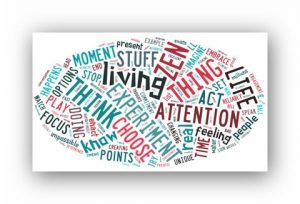
Examples of Zen Living — here’s how to simplify your life and way of being

Psst!! Hey!!!
Want more great writing designed to help YOU to shift your behaviour?
Want to learn how to find, build or deepen your principal relationship?Want to know more about Zen living and being?Want to learn how to find, build or deepen your principal relationship?
Check out Wayne’s books!!!
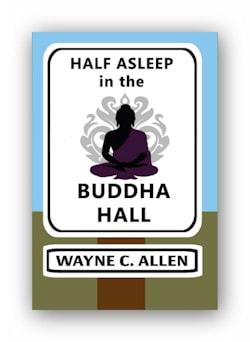
If you like this article, you’ll love my book,
Half Asleep in the Buddha Hall,
a guide to using Zen principles to re-create your life.
1. One thing at a time
 Just have a breath and focus
Just have a breath and focusMultitasking is impossible. Watch yourself when you attempt it. What you are actually doing is turning your attention from one thing to another, to another, rapidly. And, because changing your focus takes energy, nothing gets your full attention.
Experiment: watch your favourite tv show and have a conversation at the same time. See? Problems!!!
Zen living: Do one thing at a time. Full focus, to a pre-determined point of completion. Big projects require that you break them into bite-sized pieces, and finish a segment. Then shift attention. For most things, ‘chop wood, carry water.’ Do the task at hand with full attention.
2. Speak for yourself
 Preferably quietly!
Preferably quietly!The only authentic pronoun is ‘I.’ All I can reliably talk about is what I am thinking, feeling, and doing.
Example: think about something you might consider a ‘we’ thing. “We’re going to play ball.” Well, maybe a bunch of people are each, individually, playing ball, but there is no ‘we,’ period.
Nor can you say anything reliably about another person. “I know what you are thinking,” is impossible. I only, at best, am aware that I think I know what you are thinking.
Zen living: Speak only for yourself, by using “I think…”, “I imagine…”, “The story I’m telling myself…”, etc. Own your experience, and share it, as it’s all you can ever know.
For more hints on how to have an excellent relationship, read this article!
3. Choose
 I want em up… no… down!
I want em up… no… down!You may be able to play around in your head, and come up with millions of options, but (see point 1) you can never enact more than one thing at once. Thus, creating a million options is enacting a single thing - the act of imagining many options. Therefore, choosing to think of options as opposed to picking one and doing it is a choice.
Experiment: See if you can find anything you do (think, feel, interpret, etc.) that you are not freely choosing. Once you get this, you’ll quickly stop messing with yourself, and ‘simply choose.’
Zen living: choose one thing, commit to it, and see it through. If you do not like the result (this is important!) choose something else, and try that. Stop doing what does not work!
4. Be grateful
 Because you’re never in over your head…
Because you’re never in over your head…Everything is One, and everything is connected. Nothing exists as a singularity, on its own, apart from something else, and everything comes from something else.
Experiment: Think about the stuff around you, and see connections. For example, I’m presently eating a salad with tuna fish. Apart from Dar, who made the salad for me, imagine the countless people involved in making that salad possible — farmers, fishers, packers, pickers, etc.
Zen living: Be grateful. You wouldn’t last long if not for the people and ‘stuff’ that surrounds you — the air, water, land, etc. Call this to mind as you engage with the stuff of life, say ‘thanks,’ and really mean it.
Examples of Zen Living come in all flavours!
5. No duality
 up. There’s only me.
up. There’s only me.Of course, stuff happens that we know ought not to happen. It is a real, and crazy world out there. That being said, labels are inherently useless. No good, no bad, no right, no wrong. It’s all ‘as it is.’ What is, is, and what is required is not a lecture but an action.
Experiment: This is an exercise in consciousness. If you are attracted to something, move forward and embrace it. Try it out, and see what happens. If repelled, move away, and act forcefully against it.
Zen living: No duality. Know that judging is something you’ll do until you die, but you can notice and stop your mind for a moment, and then act in keeping with your feelings, interpretations, and intentions. Most say, “Isn’t it awful” and do nothing. Instead, say, “It is what it is,” act, and move on.
6. Detach
 No sense being caught in your imagination
No sense being caught in your imaginationAttachments are silly, and based upon the idea that I can grasp someone or something, and by the act of grasping, keep it the same, or ‘just keep it.’
A friend wrote: “I don’t want the fantasy to end!” Guess what: it already has ended, and had to end, because nothing is static — all is in motion — all is change.
Experiment: Create a list of all of the things, by force of will, that you have kept ‘exactly the same.’ Is a list a list if there are no items on it?
Zen living: Detach. Let go. Hold loosely. When you attempt to grasp someone or some thing, you are actually trying to hold on to, and freeze, the past. To do this requires that you exit the moment, and go into your head, and play with memories. Memories aren’t real. Real is here and now.
7. Pay attention
 If only so you don’t look like this
If only so you don’t look like thisBe Here Now. It’s the only way to actually have a life. Mooning over the past or living in the future “…then I’ll be happy…” is a sure fire way to get into trouble. You snooze, you lose.
Experiment: In Zen monasteries, a bell is rung at irregular intervals.
The monks stop, and contemplate their level of ‘presence’ when the bell rang. Find a way to do the same — perhaps set a timer, and see where your attention was when it goes off.
Zen living: Pay attention. As you find yourself drifting off into thoughts and plans, plots and dreams, have a breath and bring yourself back to now. Interesting, real stuff is happening, and can only be appreciated by bringing yourself into the This Endless Moment. And what does it say about you if your fantasy life is more chargy and fun than your ‘real life?’
8. Make contact
 It’s as simple as asking
It’s as simple as askingBeing present by definition is a reaching out and embracing of life, and then a letting go. In this way, my hands are empty and prepared for the next embrace.
Think: Most people live in an invisible bubble, designed to keep ‘bad stuff’ out and ‘good stuff’ my private property. Yet, it is only when I let down my ‘shields’ that I can interact with the moment.
Zen living: Make contact as you imbibe life. Take it in, touch it, caress it, set it free. Be passionate about your engagement with what you encounter, never wavering in your ‘present moment’ focus.
Keep going for more examples fo Zen living.
9. Don’t do it, be it
 Whatever it is, do and be it!
Whatever it is, do and be it!Zen living and being is not a game of, “look at my new skill set!” One guy couldn’t figure out how to make time to meditate. I suggested he think of his entire life as meditation. Different focus, different direction.
Zen living: Don’t do it, be it. Live life as an action that encompasses your being or essence. This is tricky to language, but it’s about a full, purposeful commitment to a way of being that includes thought, feeling and action. Take the other 9 points and see them as focusing points as to what such being might look like, as you enact yourself in the here and now.
10. Celebrate
 Dance it out!
Dance it out!Indeed, you are unique, just like everyone else. Your uniqueness is contained in the gifts you possess and your willingness to empty yourself as you share ‘your song.’ Most are so fearful of being laughed at that they hold their unique song in. How sad.
Zen living: Celebrate. Dance in the rain, sing your soul, shout your art, be your being. You are the only ‘you’ that will ever exist on this planet. Be yourself, and see with clear eyes. Your smile will set the world aflame.
Read Half Asleep in the Buddha Hall for more examples of Zen Living
July 18, 2020
Zen and Being Yourself
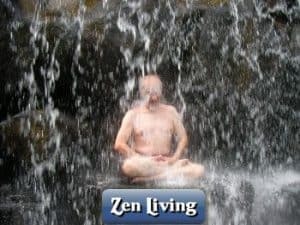
Synopsis: zen and being yourself — reality is that which is right in front of us. Descriptions of reality are convenient fictions.

Psst!! Hey!!!
Want more great writing designed to help YOU to shift your behaviour?
Want to learn how to find, build or deepen your principal relationship?Want to know more about Zen living and being?Want to learn how to find, build or deepen your principal relationship?
Check out Wayne’s books!!!

Want to learn more about this topic?
See: Half Asleep in the Buddha Hall
As long as you are trying to understand reality or you yourself in phenomenal terms it is not possible. When you understand that there is something more than spiritual or material, more than right or wrong, that is reality. That is actually each one of us. To know this is to have renunciation, to be free from ideas of right or wrong, life or death, spiritual or material…That is actually zazen—to go beyond various ideas and just be yourself. p120-121
Not Always So, Shunryu Suzuki
Most of the people I come across are trying (desperately…) to have an experience other than the one they are having.
Which, I suppose, is sort of an authentic thing to want, given that the thing they want to change is something they consider crappy. (On the other hand, the things that are happening to us are happening for a reason — so that we might, just possibly, actually learn something…)
The people wanting a ‘better’ reality also have something else in common.
They think that what they are facing is external, and they spend their time trying to get externals to “change and behave.” Another popular pass-time is to waste one’s life trying to figure out what the “right” thing to do is, or even more fun — “who is right?”
As our quote above says, the path out of this illusion is achieved by: “just being yourself.”

Example: I was talking with a friend the other day, and I made a distinction for her. She mentioned that none of her relationships had worked out. I replied that the word relationship is a convenient fiction — that no one, during my 32 years of doing counselling, ever brought a relationship into my office.
What did show up was one or more people, who then tried to tell me about their relationship, sort of as if it were, say, their car.
Now, you may be thinking, “Of course I have a relationship! I have the marriage license to prove it!” Or, “I gave birth to the little bugger, so of course I have a relationship to him! He is my son!”
Well, I’m here to tell you that this is a convenient fiction. It is a name you have given to something non-existent.
And it’s not just semantics. It boils down to this: any external problem you think you have is simply a figment of your creative imagination. It cannot be any other way.
Objects have independent reality, sure. The computer monitor or device screen you are reading this on actually exists. It has a name – “screen.” How you feel about this screen, however, is entirely about you, and has nothing to do with the object “screen.”
Same with your “relationships.”
“Relationship” is a convenient fiction for defining the parameters of something. It’s handy to say, “I am in primary relationship with Darbella.” When I say that, however, and leave it there, you have no idea what I mean by “primary relationship.” When you read the words and started thinking about a “primary relationship,” what you came up with was your definition of that term, not mine.
“Well, doesn’t everyone mean the same thing by “primary relationship?” Of course not! It’s silly to assume that we all think, and reason, and judge alike.
So, anyway, back to my friend. She and her current partner spend endless hours talking about how they want their relationship to be. Most of it is a judgment that the other person is not doing it right.
Notice the word “it.” There also is no “it.” If there is, show “it” to me. You can’t.
“It” is erroneously used as a thing I describe: such as,“It’s hard to be honest all the time.”Let’s say that in a way that has meaning: “I make it difficult for myself to be honest.”
See the difference?
Now, I’m sure you can guess where I went with my friend. I said that there is a great difference between a (non-existent) relationship and “relating.” Relating is an adverb. An action. An activity. As such, you are either doing relating, or you are not.
And here is the kicker: Whether you do or do not do relating is entirely up to you!
“Wait a minute,” you scream. “What about my partner? Doesn’t he have to be relating too? And he isn’t!! So, I’ll be damned if I’m going to go first!”
Nice try! That’s you, trying to get off the hook for your behaviour.
Solution: “Just be yourself.” Being yourself is the name of the game!
What this means is that all we can ever do is to be ourselves.
Or not. I can blame externals: you know, sit back and gripe, and moan and complain about how hard done by I am, how stuck I am, how often I don’t get what I want.
If this is what I do, then I am resisting being myself. Being myself requires that I take total responsibility for the only thing I can control… my actions.
You have noticed that it is almost impossible to control your thoughts, right? Thoughts “just show up.” That is reality for all of us. Including Zen masters. The question is not, “Can I get rid of stupid, negative, harmful thoughts?” (Answer: no.) The question is, “Can I let go of attaching to my thoughts?”
Emphatically, yes.
With the effort of being yourself..
 Tangled in thought
Tangled in thoughtMy thoughts are just the way I label my reality. “My partner is a jerk.” “Everyone is out to get me.” “My parents screwed me up.” Whatever. “I’m really, really sick.” Of course you are. That’s what you believe, and that’s how you behave, so you’re right.
The alternative is to sit with your thoughts, notice them, and let them go.
Now, in Zen, zazen (which means, “sitting still, like a mountain,” or, in other words, meditation) is key. And is also an action. You can’t think about sitting – you sit.
This is what “getting it” is all about. It’s not what words you say, nor about what you think. It’s about how you act.
“Nothing you say matters. All that matters is what you do.”
I hear people swear that things are going to be different. They get it. They’re changing. “From now on…” And then, a week later, they are doing the same old stuff, getting nowhere, and are still blaming others. For not “letting them get it.”
Well, crap.
I wrote in This Endless Moment that the only excuse is the military one: “Sir! No excuse sir!”
That is the last thing many folk want to hear, because they are such poor, precious little things — “How can cruel, insensitive Wayne not see how hard my life is, how sick I am, how screwed up my partner is, and cut me some slack?”
Crap.
No slack. No nothing.
Do you want to be alive, be yourself, fully yourself,
fully present, and content with your life?
Then here is how you do it:
Being Yourself meant to
do what works and
stop doing what does not work.
Now.
No excuses. No blaming. No looking for an exemption. No trying to fix others. No focus on what others are doing. All of that is irrelevant and not worth your time.
Look at how you are “sitting” and settle in. See what is happening right now, with no judgement, no blame, no clinging to how you defined it a moment ago. Now is just as it is, and now is always perfect.You may not believe what I am saying, but let me ask you one question:
How well is your present belief system serving you?
If you are not content, you are not being yourself; your belief system is holding you back from being you.
Your ego will want to make excuses and complicate this understanding, because if you confuse yourself,
you stay stuck,
and stuck is the main purpose of your ego.
If you are not content, act differently,
without explanation or excuse.
It’s as simple as that.
June 12, 2020
On Finding Your Flexibility
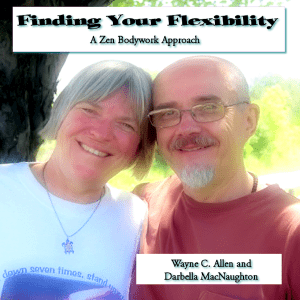
Finding Your Flexibility — Some years ago, the Worker’s Compensation Board in Ontario invited me to start working with injured workers. Darbella and I taught them meditation, qi gong, and some yoga stretches.
We thought we were going to take the project province wide, but then the government shifted priorities, and stopped hiring outside consultants. Or something like that.
So, we had all of this material, and decided it was so good, we’d turn it into an online course. And that evolved into a pdf booklet, and online videos.
On the off chance that you might be experiencing any kind of pain (physical or mental), this course might be for you.
Check out Finding Your Flexibility here!
Here’s the introduction!
Introduction
This is the first in what will be a series of book-online video combinations. Our goal is to make Qi Gong, Meditation, Stretches and Breathwork ‘do-able’ by people beginning these practices in middle age, and by people with physical limitations. We designed this program because of a request from Ontario’s Workplace Safety and Insurance Board, to aid injured workers.
The Phoenix Centre’s work is always integrative, and part of “integration” is theoretical. In other words, you need to “get where we are coming from”—to understand the concepts that underlie the exercises. You don’t have to accept or believe them—just hold them loosely in your mind as you experiment with the techniques on the on-line videos.
After one seminar, a participant said, “I am really in pain. Nothing has worked, and it’s only going to get worse. Now you show up with these ideas. I can’t accept them until they work, and they can’t work until there’s a change in my body mechanics.”
I said, “Or, you could just give some of this stuff a serious effort, and see what happens.” He paused, and then said, “It can’t hurt, I guess.”
I would only ask one thing of you. Approach this process with an open mind, and actually do the exercises on the on-line videos. Read and re-read this book, and commit to 30 days of repeating the exercises. See where things are at that point. There are no guarantees in advance, other than this one:
If you keep doing what you’ve been doing, you’ll likely get the same results.
Medical Disclaimer:
In the interest of avoiding injury or mishap, any kind of strenuous physical activity conducted without the assistance of a professional coach or trainer should be discussed with one’s physician or personal healthcare advisor. The exercises and advice put forth in this book and on-line videos are by no means a substitute for medical care or expertise. Never over exert yourself. If you experience any sort of discomfort stop immediately and, if necessary, seek medical attention.
Self-Responsible Pain Management
Throughout this book, and to some extent on the on-line videos, I’m going to describe Eastern and Western approaches to living, to Bodywork and exercise, and to pain management. I want to help you see how combining these two approaches might be the smartest thing you ever did.
My initial training was in Western psychotherapy, which is often called the “talking cure.” There were body elements to this: we looked at breathing; we did psychodrama (acting out scenarios, in groups) and studied Gestalt, which has many physical aspects.
In my clinical practice, I had years of success with the “talking cure.” What I noticed, however, was that the relief tended to be mental—in other words, people gained communication skills, better understanding of their stories, and tools for talking through emerging issues. What wasn’t happening was any (or much) change on the physical level. People with great mental coping skills were still in physical pain, and things weren’t getting better with time.
I started exploring Eastern philosophies and techniques, to see if I could find something to try. I learned that there was a direct and fundamental connection between what people thought (clung to,) and what was happening in their bodies.
In 1996, I attended a 25-day program at The Haven, near Nanaimo, B.C. There, I learned a Western version of Bodywork. I learned Bodywork theory—that our bodies hold within their physical structure the story of our unresolved issues and past traumas, physical and psychological. A trained Bodywork practitioner can simply look at how you carry yourself and can thereby tell you much of your life story.
Bodywork emerged from the insights of Wilhelm Reich, a 20th century psychoanalyst. He identified what he called “character traits,” and decided that such traits were reactions to the person’s rejected (and blocked) emotions.
His idea was that people developed rigid personalities, made up of various internal stories—these stories, if left unexamined, became rigid states as opposed to flexible choices.
Reich decided that character traits were held in place by the person’s “character armour,” which is an actual tightening of the muscles of the body. He further discovered that guiding clients into their tightness, (through Breathwork and applying pressure to the body,) helped clients to break through the character armour, and from there, to begin to disassemble the ineffective character traits and stories.
So, let’s apply this to you. You might ask yourself:
“Why do I experience pain in this part of my body, and
what’s the story I tell myself about it?”
I think you might discover that there has been significant tightness in the part of your and now, this same tightness adds to the pain you feel as you work with this area. There is more happening beneath the surface than is immediately apparent.
Well, that was a bit about Reich and Western approaches. Of course, other Western tools are things like physiotherapy, drugs, and surgery.
On the Eastern side of things, Eastern methods assume that the body is filled with energy. This energy can be directed, and used for healing. You’ll hear us talk a bit about meridians, about energy (called chi or Qi,) and about how energy blockages cause the body to be “out of balance.”
In Eastern thought, our bodies are seen holistically, as BodyMindSpirit. We are designed to naturally be in balance. Internal illnesses and external injuries cause the energy to flow non-naturally, and this in turn leads to pain and inflexibility.
Pain reduction and increased flexibility are goals of this program—we assume that this will happen as the body comes more and more into balance. In other words, through specific exercises and meditation, we’ll treat the imbalance, and allow the pain and stiffness to take care of itself.
We mentioned that there are things you’d need to “get,” and here’s the first one. You will need to see how your BodyMindSpirit is right now as part of a longer ‘story’—in a sense, to accept the idea that your body is holding unexpressed emotions and traumas that pre-dispose you to be in less than optimal condition.
We call this understanding “the core of self-responsibility.” In other words,
“I am how I am, right now, because of how I thought, acted,
and dealt with my life, up to now.”
I’m asking you to look to yourself, to identify areas you have been ignoring, and to gently turn your attention to those things. No one but you can turn the tide. You’ll have to break habits and learn to think and act in a new way, but hey, the way you were doing things hasn’t exactly panned out, now has it?
The real work is always self-work.
The simplest way to begin is to have a sense of humour. Notice how you stay stuck, notice where in your body you are tight, and smile and shake your head. If you do not like how you feel or how you are thinking, change your focus and direction. In other words, no matter what, fix yourself as soon as you notice you are going off the rails.
No matter how bad a situation seems to be,
it will only change when you do.
It’s important to watch how we deal with events that seem larger than life—that we think of as “Not fair!” Gathered under this umbrella are things like death, illness, accidents, pain, suffering, global catastrophes, abuse, and the like.
When we are kids, we hear fairytales about people living ‘happily ever after.’ We believe in Santa and the Easter Bunny. Then, we grow up, and give up on Santa, fairies, and the Bunny, but seem to keep the ‘magical thinking’—if I am good, only good things will happen to me. For free. All the time.
The other side of this coin is the idea that if ‘bad stuff’ happens, the recipient must have ‘deserved it.’ It’s thinking, “Bad things only (or should only) happen to bad people.” If you hang around wakes or funeral parlors, and if the dead person died of anything other than of old age, you will hear some moron say, “I wonder why God was mad at him. I wonder what he did to deserve this.”
Being a practical, Zen person, I wonder, “Why not this person?”
What, exactly, is “fair” treatment? There is no such thing. There is just the truth of life—this happened, and this happened, and this happened.
The reality of our lives is that we live in the midst of pain, suffering, and death. No one has escaped this. Most of us will outlive our parents. Some of us will outlive our children. There will be illnesses, accidents, pain. Wondering about “why” is an attempt to avoid confronting the reality of our own sickness, ageing, and death.
There is no why. Whatever happened in your life did happen, so what’s the sense of putting energy into the “why?” thought? It’s also useless to go a step further and start assigning blame. “Someone should have done something!” This should never have happened!”
And what changes? Nothing! It still happened.
The only cure for all of this is the total acceptance of what is. From a place of acceptance, I can then choose to act differently right now, instead of just whining about unfairness.
‘The way it is, is the way it is,’ and fairness has nothing to do with it.
Pain and Suffering
Pain is one reality that touches all of our lives. For all of us, there will be the emotional pain of grief and loss. If we are injured, there must be physical pain. In every life, pain is not optional.
Suffering, however, is optional.
All suffering is self-imposed. The Buddha’s first truth is, “Life is suffering.” But his second truth is, “All suffering is caused by clinging and aversion.” In our examples, clinging is holding on to magical thinking. Aversion is the unwillingness to embrace (accept) the reality of the pain. The irony is that such aversion, clinging, and denial is crazy making, mentally painful, makes the actual physical pain much worse, and changes absolutely nothing.
One root of suffering comes from clinging to the past—wanting everything to be the way it was before the ‘bad’ thing happened. This, of course, will not and cannot ever happen, no matter how much you wish it were so. And so, you suffer.
The other root of suffering comes from imagining the future—and making that future as grim and pain-filled as possible. I won’t get into why we do this—it’s not worth the reading. This imaginary story causes us to physically tighten up and to dump a load of adrenaline into our systems—and this, in turn, adds to our pain.
In both cases, suffering comes from hating and resisting pain. Yet, the pain is real—is part of our reality.
Ram Dass once said something like,
“Life is painful; it’s like having a hot stone placed on the palm of your hand.
You have two options.
Grasp the stone tightly and burn your whole hand, or
hold the stone lightly and only burn the part under the stone. Choose.”
Most choose hardening and tightening around the pain, while adding in the “This isn’t fair” litany. And so, they suffer.
So, what is the alternative?
The Buddha’s third truth: If you let go of clinging and aversion, and live your life fully and completely, you can let go of suffering (but not pain, sickness, and death—this is not optional!)
In other words, situations do not change—you do!
I am not minimizing pain—I am simply saying that it is ‘how it is.’ There will always be physical pain, and there will always be situations that are agonizing. There will always be depraved people preying on innocents, and tragedy and death are as much a part of life a blue skies and sunsets. Bemoaning the existence of such painful situations changes precisely nothing.
Creating another way of being with the situation is always possible. The key to living life with a minimum of suffering is to hold life, and your opinions, loosely. While it is tempting to play the “It’s not fair” game, it is essential to remember that this accomplishes nothing in the real world.
The world is neither fair, nor unfair. The world simply is. Accepting this reality, as well as our ability to deal with the pain that life brings, is essential for managing your pain.
Hold the burning stone loosely.
May 12, 2020
5 Communication Tips
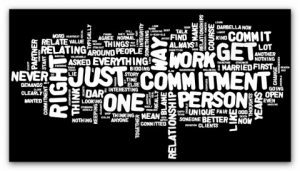
5 Communication tips — when couples have issues, the reason, almost 100% of the time, is lousy communication. Here are 5 communication tips, but also have a look at my book The. Best. Relationship. Ever.

Psst!! Hey!!!
Want more great writing designed to help YOU to shift your behaviour?
Want to learn how to find, build or deepen your principal relationship?Want to know more about Zen living and being?Want to learn how to find, build or deepen your principal relationship?
Check out Wayne’s books!!!
Introduction: What we’ve got here is failure to communicate — 5 communication tips
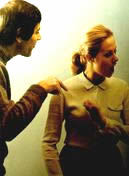
Elegant communication… NOT!!
Virtually all “couple issues” are communication issues. Superficially, the topic may be finances, sex, child-rearing, or whatever, but underlying it all is the quality and regularity of the couple’s communication. Let’s look at a few things that might help you improve in this area.
By the way, if you haven’t downloaded our two free booklets on Relationships, you obviously haven’t been exploring our website. Here’s a link to our freebies page.
1. Start Now — at least 20 Minutes a Day
Man, have I ever heard a ton of excuses for not communicating. Usually, a variant of “Don’t you know how busy I am (life is)?” Then I’d get the run-down about how tough things are at work, how the kids are in 20 activities each, and how making 20 minutes a day for one’s partner / spouse was impossible.
 It shouldn’t be so hard!!!
It shouldn’t be so hard!!!What’s really being said? “I don’t want to have to put in any effort at all in my relationship. It should ‘just work.’ ”
And how’s that working for you?
Most folk have this odd dream that being with the ‘right person’ means, “Now I can relax, and everything will work out just fine.”
Since this never happens, the silly and dumb among us think something’s wrong with their partner.
Communication is a skill. It’s like learning a foreign language, as no one is a born communicator.
Occasionally people think Darbella and I are ‘naturals’ at it, and blow me off on that basis. The truth is, we have made clear communication a top priority, and we don’t allow mistakes to stand.
Take away point: Start today. Sit down with your partner, and establish some ground rules.
1) Frequency (no excuses) of at least 20 minutes per day.
2) Sharing: how (including using a timer) you are going to split the time
3) No interruption rule. Communication requires listening, not defending your position.
2. No excuses
This follows from point 1.
You must drop the idea that being in relationship is, or is supposed to be, easy. Sadly, most people haven’t read my book, Find Your Perfect Partner, and thus are in relationship with someone likely from one of the further rather than nearer planets. Despite this, (which you set in motion…) excuses are going to get you nowhere.
Busyness: yeah, right. There’s a gun pressed to your head, forcing you to say ‘yes’ to everything. Since when is saying ‘yes’ to everything a clever strategy? And if this was so, how come you’re not saying ‘yes’ to deep, intimate conversation with your partner?
Boredom: I suspect most of my clients find their partners to be boring and uninteresting. (And, of course, they’re too chicken to say “I’m boring myself in this relationship…”) There is so much eye-rolling and talking over, so much walking away, and fighting. This is a variation of “I’m in relationship with the wrong person!” Our advice: leave, or get interested!
Take away point: Many are the excuses for staying stuck and simply complaining and blaming. Excuses are the creation of lazy minds. If you seem to have little time, have a conversation about how this keeps happening, and work with your partner on learning to say ‘no.’ If you’re bored, tell your partner how you are boring yourself (hint: it’s never about your partner) and suggest specific ways to do something interesting.
3. Use “I” language
I listen to couples talk, all the time, and with poorly functioning couples, the pronoun most used is 2nd person — a form of ‘you.’ The main uses are to blame and to psychoanalyze.
Again, this is the result of laziness and a decided lack of self-responsibility.
Judgements (blame) are always about pointing the finger at others. You did this, you did that. See how badly you treat me. And then, a sitting back, arms crossed, and an expectation that one’s partner will change.
How rude.
The odd piece for me is that such blaming/demanding is always one sided. Each partner doing this expects the other to do what they are told. Yet, when the partner tosses out their list, the reaction is, “How dare you tell me what to do!”
Instead, shift the pronoun to ‘I’ — “I am uncomfortable with our level of communication, and here is what I am going to do about it.” “I am sad that (whatever) is happening, and here is what I will do to change this.”
Take away point: “You” language feeds into the problems mentioned above.
“You” language maintains the status quo, sets up power struggles, and places responsibility for change on the other person.
“I” language is self-responsible language, and when followed through with, leads to change.
4. It’s almost never about what you think it’s about
The main reason for a good communication style is that you can talk about what’s really up for you. Sadly, most people fear the ‘big’ issues, so they talk symbolically.
“If you loved me, you’d spend less time at work.” Maybe the person really is camping out at work, but almost always the real dilemma is this: “I am making myself feel distant from you. I think I’ve been abandoned, and I’m missing you, and I fear you no longer love me.” Notice that the first statement is about ‘stuff,’ and the second cuts to the heart of the matter.
Now, re-read the second statement. Given the “I” language, the sentence really says, “Here is the story I am telling myself.” There is no blame, no demand, just a clear statement of “Here is me, right now.” Note: “I fear that you do not love me” is different than “You don’t love me.”” The first is self-responsible and about the speaker. The second is blaming and mind-reading.
Take away point: Ask yourself what you are really upsetting yourself about, and talk about that, using “I” language.
If you are on the receiving end of an honest, “I” centered statement, thank your partner for sharing, and ask, “Is there anything I can do?” The authentic reply: “Yes, here is what you can do right now.”
5. Curiosity trumps ‘knowing’
No, you don’t know what’s up for your partner. Once you truly grasp this, you’ll stop second-guessing and start asking.
In the above scenario, the “Is there anything I can do?” question is also a “Is there anything I can do right now?” question. You can’t fix the past, and you can’t fix the future. You can do ‘right now,’ as that’s all there is.
The ‘communication key,’ if there is one, is to stay in the now. Here is what’s up for me, right now. here is what I want, right now. Here is what I hear, right now.
Once you get the hang of this understanding, you will also get that guilt and blaming is always about lists of past events, to which the present event is precariously attached. Again: it is impossible to fix old stuff. You can only work, do, be, in the Now.
Thus, you might also understand that your remembered history with your partner is useless in the ‘now.’ Since this is so, your only option is to ask, “What can I do, right now?” “How are you, right now?”
In other words, when on the receiving end of any statement, your choices are defensiveness or curiosity. Guess which one leads to a fight, and which one leads to more information?
Take away point: Once again, decide. Do you want to fight (and thereby avoid dealing with the big questions), blame (thereby escaping responsibility for where you are) or do you want to deepen the relationship? If the latter, get curious!
May 4, 2020
On Just Sitting
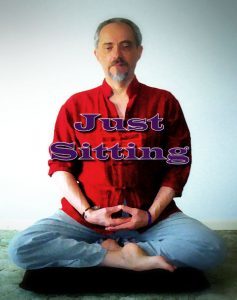
Just Sitting — a way of doing meditation that needs nothing. NO counting breaths, no mantras. Just sitting.

Psst!! Hey!!!
Want more great writing designed to help YOU to shift your behaviour?
Want to learn how to find, build or deepen your principal relationship?Want to know more about Zen living and being?Want to learn how to find, build or deepen your principal relationship?
Check out Wayne’s books!!!
 Finding Your Flexibility
Finding Your FlexibilityWant more help with things like dealing with stress, learning to combat pain naturally, meditation and Qi Gong? Check out our Book / Videos packet, Finding Your Flexibility. It’s a pdf guide, and a group of online videos.
Rather than Just Sitting, our upbringing and nature cause us to complicate our lives.
One way we do this is to assume that the stuff of life is here for us–personally. Rather than seeing ourselves as a part of something, we see everything as here for us to play with. So, for example, something simple (like meditation,) is declared to have a “point,” and that point is to be of service to me.
If you want to see this, try Googling “meditation.” What you’ll see is a myriad of organizations, ideas, and “reasons for meditating.” A simple thing has become what is described in the Tao as “the 10,000 things.”
Thanks to the Mindfulness movement, meditation has become a “tool” designed to aid digestion, reduce stress, cure phobias, and fix what ails you. This fits with the decidedly western notion that what we do ought to have a “goal.”
Which is not to make goals wrong. It’s to say that the beginning of wisdom is to be able to see that there is something else going on.
We are trained to become identified with the story we tell ourselves, and that in turn leads to us seeing everything through the lens of “me.” How does this serve me? What will I get out of it? How can I use this to my advantage?
And beneath this, almost unnoticed, is the energy in which we swim
The Taoists talk about it as an energy field from which “things” (including us!) arise. Energy becomes manifest–it is contained in the thing that arises. In the Tao te Ching, the writer uses a cup as an example:
XI (trans. Ted Wrigley)
We fire clay to make a cup,
But we use the empty space in the center
We build walls to make a room,
But we use the empty space they surround
We form a wheel to spin,
But we need the axle hole to use it
The point:
Having something is good only to the extent
That it makes nothingness usable.
Here’s part of the introductory section:
I (trans. Ted Wrigley)
A path is just a path, a name is just a name
What is, is, without sense or differentiation
And only divides itself into things [often trans. ‘the 10,000 things’–WCA] when we give names.
Forget the names of things and you sense fit and flow
Use their names and you see uniqueness, significance
Each perspective is as true as the other.
(For more on the Tao, see my book, Half Asleep in the Buddha Hall)
The assigning of names is a human activity. The names aren’t really a problem; that comes with the assigning of categories: good / bad, for example.
The Tao tells us that names are one side of a coin, and Tao (the underlying stillness) is the other. Focus exclusively on one, and it‘s hard to see the other.
Why we meditate
Without getting into “right,” one might choose to use meditation as a way to shift gears enough to see the underlying nature of being. That was certainly meditation’s original “face.”
Things have changed.
At the start of this article, I mentioned how many different types, and places, and “reasons for” meditation there are, and it wouldn’t be hard for me to “like” some, and “dislike” other types, or styles.
That there are many types is neither good nor bad. It just is. Finding the need to judge one over the other, on the other hand, kind of takes us away from the essence.
For several years Darbella and I studied a family style of Tai Chi, and enjoyed it. Then we moved, and decided it was too far to drive to get to the class. A while later we found another school, this one an institutionalized brand of Tai Chi that shall remain nameless.

We went, and learned their short set of moves, which was different from what we knew (the order of the moves) and slightly different regarding the moves themselves. I found myself occasionally reverting back to what I knew, and this seemed to annoy the wife of the guy teaching us.
Eventually, she stormed up to me and demanded to know what I was doing there, and that I “…wasn’t allowed to teach this style, and I’m watching you!” All this judgement, both over style and substance.
Weird, as all I was doing was moving my hands a bit differently from what she was used to
This would be the “good / bad” thing, writ large. She’d made some rather strange speculations about me and my motives, and then just clobbered me with them. Labels get in the way.
Shikantaza
Shikantaza is a Japanese word that is popular in Soto Zen (a school of Zen.) It roughly translates as “only just precisely sitting.” Or, as I put it, “just sitting.” In this school of thought, just sitting is equivalent to waking up.
In other Zen schools, zazen (meditation) might be taught using props or techniques — chanting, counting breaths, doing mudras (hand positions.) In Mindfulness meditation, goals are stressed, or better, outcomes–like lower blood pressure, for example. In these cases, meditation is a tool to get someplace else.
This is done for a reason
Because of our tendency to both label and judge, it’s easy to get confused when our minds don’t do what we think they ought to do. For example, many think that the point of meditation is to quiet the mind. And when they discover how difficult that is, well, “I just can’t meditate,” or “I must be doing something wrong” pops to the fore.
So, the other meditation schools came up with techniques to distract the mind–by giving the mind something to do, like counting breaths, or whatever. They realized that, without a target, the mind is going to wander, and obsess, and story-tell, and this could lead to a not so good experience.
To toss a bit of Tao into the mix, though, wandering is what the mind does, (it is the nature of mind) so therefore, fighting it with techniques is likely doomed to failure.
Shikantaza suggests an alternative (not right or better) and that is just sitting. And observe. To see the nature of mind.

And that nature is restless, at least to begin. It’s called monkey-mind, and if you’ve seen monkeys in the wild, you’ll know that they often are restless, and moving from branch to branch.
With shikantaza, you sit, and you watch your mind. You may have an image of clouds moving across the sky. A thought arises, and, unimpeded, will drift across your mind like a cloud. To be followed by another.
A difficulty arises when we latch on to a particular thought. The story we tell ourselves about the thought takes over, and we flesh it out, playing all the roles, having a dialogue, a fight, whatever. This is monkey-mind.
Now, because we were yelled at as kids for being “bad,” the norm is to yell at ourselves for getting distracted. Then we get to have another internal fight, and declare ourselves incapable of sitting quietly. Maybe I should count breaths!
But nothing works, because this is the nature of mind.
So, what to do?
Notice. Let the thought go. Have a (non-counted) breath, and watch. And another thought will arise, and this time, maybe I can just watch it drift by.
This is the truth of Shikantaza. Mind is as it is, and resisting leads nowhere, so if I can just be with what is, I can be in the flow.
I can touch the Tao. The base. The thing that underlies the 10,000 things.
In glimpses, we we see what is there, in that dark silence. We see the nothing that makes up all things, and perhaps we see it for as long as a second or two. In that second or two, we are awake.
Bringing Just Sitting out into the world

Meditation is a tool for waking up, but it would be a pretty lame one if it only worked on a cushion.
The other day I was doing some wiring. My first discovery was that the person who had installed a light had done a dangerous job, and I started off on an internal and external rant.
Then, I realized that this was not helpful, so I had a breath, took apart the “bad” wiring, and replaced it.
Over the next hour, I found myself focussed on the myriad of wires; connecting, pulling cable, cutting, stripping (the wire, not me.)
Very Zen.
Because I was doing what I was doing, and only that. Oh, I was talking a bit too, but mostly focussed on the necessary patterns of connection.
Zen wiring.
Just sit. Find the time to watch the judgements and monkey-mind. Breathe. Let it go, just for a minute. Or a second. and see if you can see the stillness that underlies everything.
Not one better, one worse. Just to see it all, and be it all, without needing to hold on to any of it.
April 20, 2020
Learn Meditation for Difficult Times

Learn Meditation–a skill and a practice that we talk about a lot. It’s in my books, and a part of our life.

Psst!! Hey!!!
Want more great writing designed to help YOU to shift your behaviour?
Want to learn how to find, build or deepen your principal relationship?Want to know more about Zen living and being?Want to learn how to find, build or deepen your principal relationship?
Check out Wayne’s books!!!
 Finding Your Flexibility
Finding Your FlexibilityWant more help with things like dealing with stress, learning to combat pain naturally, meditation and Qi Gong? Check out our Book / Videos packet, Finding Your Flexibility. It’s a pdf guide, and a group of online videos.
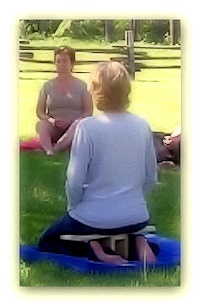 Kneeling Posture
Kneeling PostureMy own experience with meditation began in 1969, and good ole’ Elmhurst College. There was a Transcendental Meditation Group on campus, and I checked it out.
One thing I learned was that I didn’t like mantras — you got “given” one by the leader, and were supposed to focus on it as you “sat.” My little mind never did like being told what to do… at least by outsiders.
But I liked the idea of “just sitting,” and did so in fits and starts for some years. Some decades later, having spent much time reading Zen literature, I decided we needed some formal Zen training.
Off Dar and I went to the Toronto Zen Centre
The process there was pretty rigid and formal, and again, nether of us were fans. But the leader was kind of neat. We had a long “sit” and practiced a couple of the “normal” Zen techniques:
counting breathscounting only in-breaths
This was preceded by lessons in how to sit.
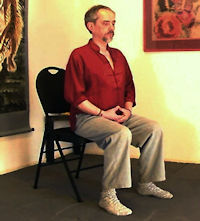 chair meditation
chair meditationI still believe that “proper” meditation involves cushions and one of the approved of postures. But as I’ve gotten older, and because we are now tavelling most of the time (hence no cushions), I’ve come to believe that any “sitting quietly” time is better than none.
Let me outline a seated in a chair posture, and then give you a couple of focus suggestions.
I’m presently writing this in Spain and am sitting at the dining room table. The chairs are wooden. They’d be perfect for meditation.
You want a firm, solid, un-padded chair.Sit on the front half of the chair, so your back IS NOT touching the chair’s back. Plant your feet firmly on the ground, maybe a foot or so apart.Sit up straight. Imagine that a hook is attached to the top of your head, and is pulling upward.Sway a bit side to side, feeling for “centre.” Sway a bit front to back, feeling for “centre.”Keep your eyes open and relaxed, and tip your head down just a tad, so you’re looking 4–6 feet ahead.Cross your hands on your lap.
Of course, there’s a video.
Click here for video
How to Quiet Your Mind
Meditation is not, as people often mistakenly assume, about emptying your mind of all thoughts. The nature of our mind is to have thoughts. Thoughts arise and will persist in doing so if we try to stop them. Buddhists call this the “monkey mind.”
Rather, we can give the mind something to do; whether that’s counting breaths, or simply watching itself do its thing.
Counting breaths: Our little minds do like assignments. This one is simple. Count each in-breath and each out-breath. Try to get to 20.
You won’t… but try.
You won’t because our minds get bored, and are also quite used to tossing up dumb thoughts. So, when a thought arises, have a breath, and start back at 1.
Just sit: There is a whole school in Zen devoted to “just sitting.” Instead of counting, just breathe comfortably. As a thought arises, say internally, “thinking.” Let the thought go.
Remember: Our tendency is to follow our thoughts. We see a scene from our past, and poof, we’re 20 and meditating at good ole’ Elmhurst College.
So, the goal here, such as it is, is to gently stop the thought-stream. As soon as you notice you’ve pulled an Elvis (you’ve left the building…) have a breath, and come back to just sitting.
Do either of these methods for 15 minutes per day. for a week or so. If it’s working for you, go for 30 minutes.
That is basically it. Thoughts will come and go. We do not need to lay any heavy trip upon ourselves for having thoughts. Just notice them, and remind the mind of its task.
Breathwork
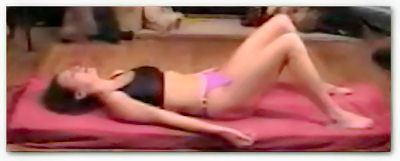 Breath Posture
Breath PostureBreathwork is a Haven creation, and a great way to get into your body before or after a “day to remember.” No props necessary.
Lie on your back.Raise your knees so your feet are about one foot from your butt.Move your feet so they and your knees are about a fist’s width apart. (Obviously, insert your fist between your knees to check.)Close your eyesOpen your mouth an inch or so.Breathe. The in-breath should fill your lungs and elevate your chest AND your belly.Breathe out. On the out-breath, make a sound, starting with “ah.”As you breathe, you can massage your jaw hinges.
Here’s a video!
Check out our page on Breathwork, here.
Give this a try, and notice how quickly emotions arise. Just let them come.
March 31, 2020
Cling Static

We get cling static whenever we find ourselves grasping onto something (or pushing it away–in which case we’re clinging on to not having it.)

Psst!! Hey!!!
Want more great writing designed to help YOU to shift your behaviour?
Want to learn how to find, build or deepen your principal relationship?Want to know more about Zen living and being?Want to learn how to find, build or deepen your principal relationship?
Check out Wayne’s books!!!
Today’s topic is addressed more fully in my book, Half Asleep in the Buddha Hall.
One of the earliest teachings of the Buddha concerns the nature of life, and is often called the Four Noble Truths, or perhaps more clearly, the 4 Preeminent Realities.
Or, 4 Descriptors of the way it is.
Here’s the text version of the 4 descriptors, as well as an illustration, both from the book.
1) Life, and our sense of an individual self, leads us to a feeling of dukkha, or unsatisfactoriness. Dukkha is typically translated as ‘suffering,’ but the word actually refers to anything that causes us unease.) We judge that the way life is, and the way we are, is ‘not quite right.’
2) The root cause (samudaya) of this sense of unsatisfactoriness is tanha—“thirst”—often translated as desire, or craving—which is expressed through the evil twins of clinging and aversion. Psychologists call clinging ‘the maximization of pleasure,’ and aversion ‘the avoidance of pain.’
The desire to hold on to stuff, while desiring to avoid other stuff, leads to a sensation of unsatisfactoriness.
3) The way out of this cycle is through cessation (nirodha). If I stop desiring, (through the disciplining and emptying of the mind) and live in the Now (because desire is always about wanting (or avoiding) what I had in the past, or wanting (or avoiding) something in the future), my sense of unsatisfactoriness (suffering) will cease.
4) The cure proposed by the Buddha, is magga—the Eightfold Path of ‘sound living.’
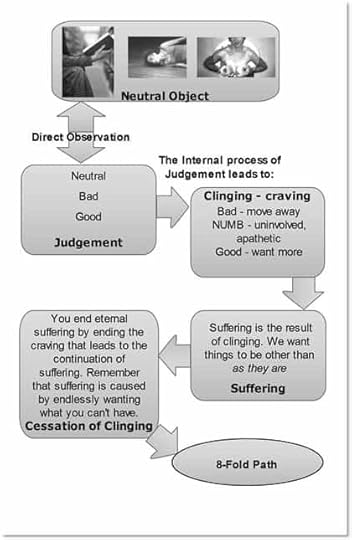
The first descriptor is typically translated “Life is Suffering,” but this English translation of the Pali dukkha misses the breadth of dukkha’s meaning. Dukkha might be thought of as pervasive uneasiness, or pervasive unsatisfactoriness. This unease can run from mild discomfort to outright agony.
If you think about it, you’ll recognize that this sense of,
“there has to be more, something else…” is prevalent
Judgement: is the expectation that
my worldview is correct, and thatthe world “should” give a damn.
“We ask, entreat, implore, intensely desire—that the world’s objects yield abiding pleasure, satisfaction, and security. But how can they? Their fundamental nature is impermanent…” Wallis, Basic Teachings of the Buddha, pg 126‑7
Now, notice the word “abiding.” Part of cling static is trying to make things last. This is especially so with things we find pleasant, chargy, erotic, desirable. Many are the people who cry, “I want this ecstatic feeling to last!” And then they blame the thing for not listening, for not lasting. And yet, the thing we forget is that nothing lasts—not people, not circumstances, and, emphatically, not us.
Investigation, on the other hand, is expressed in my favourite word regarding relating: curiosity.
In investigation, as opposed to cling static, we look at what is, imagine what could be, and change ourselves!
A cheap illustration would be Edison inventing the light bulb.
He saw gas lights, thought about its flaws, and thought, “Hmm. I wonder what I could do to come up with another way.”
He did not stamp his feet and demand that the gas light change. He recognized an intention in himself (remember, he had no advance knowledge that he would succeed in creating an electric light) to create something entirely new. He then studied, built a workshop, and started experimenting. He learned a lot about what would not work, and eventually solved the riddle with carbonized tungsten filament.
Hopefully, you can see another blatant difference between judgement and investigation.
In judgement, the focus, the light, is being directed to the external situation, person, or object.In investigation, one turns the light inward, and looks deeply at how one relates to the external situation, person, or object.In judgement, the intent is to force the external to change to match the internal picture.In investigation, one explores one’s inter-relationship between the internal and the external, with the expectation of bending the self. Releasing the self. Finding the juiciness of life in the interplay between that which I imagine and that which “is.”
Even after death, we imagine, the cling static game goes on, I’d like to suggest that there is tragedy here. What a waste! The problem is all about clinging to the image that “something better is always around the corner.”
And then, when the something better comes along, we seek something better-er. As it were.
Now, I’m not suggesting that you suck it up and stay in “bad” situations, relationships, etc. I’m saying that hanging around in bad situations with the expectation that, if you whine long and loudly enough, the situation will change, is simply absurd. It’s about accepting that I can stop making the same mistakes about situations.
Most relational mistakes have everything to do with judging as opposed to investigating.
In all cases, the way past suffering (the 3rd descriptor) is in how we live and “be” (in the Buddha’s words, the eight-fold path–the 4th descriptor.)
Investigating what you are doing, and shifting from what does not and cannot work, to what allows you to drop clinging, gives you the chance to be present, to be alive, and to be aware.
March 14, 2020
A New Model for Relating
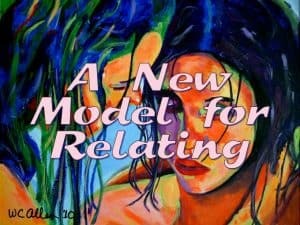
Here’s the third article, featuring the key concepts for a new model for relating.
A New Model for Relating
In This Moment
As I promised, here’s the last of 3 articles that are sample chapters from my relationships book, The. Best. Relationship. Ever. Enjoy!
If you’re looking for a partner that “fits you,” you owe it to yourself to read my book, Find Your Perfect Partner It’s available as a Kindle book here, for $2.99 US. Two of my other books, This Endless Moment and Half Asleep in the Buddha Hall, are also available as Kindle books, same price. Those two are also available from Amazon as paperbacks.
The easiest way to check out all of the books is to go to our publishing site, The Phoenix Centre Press.
In order to have The. Best. Relationship. Ever., you must have a new model for relating. This requires rigorous self-exploration, and openness, honesty, and curiosity.
Mostly, because we’re lazy, we tend to repeat what doesn’t work. Or, we try out a technique for a bit, and when there’s a bump in the road, we pull out old, non-functional ways of relating.
We get stuck in a rut, and blame the rut
Failed relating follows a pattern — the same one Sam and Sally followed. There are not many variations on this theme — get into a primary relationship at a young age, flounder about, get lousy results, end the relationship, and then, do it again!
We do this in other areas of our lives as well — for example, in academic fields we don’t like. We don’t take the time to learn a new way — we just repeat what doesn’t work, and whine about our lousy results.
Here’s an example: I’m not so good at algebra. I got through it in High School and University, but never really figured it out. I did enough to pass. I memorized a few patterns, and studied old tests, and learned what I call “brute force” algebra. I have a few rules in my head, but absolutely no understanding.
Because I like to torture myself, when Darbella (who is great at math) taught algebra to her 8th grade Math students, I’d occasionally try one of the more complicated problems.
I’d just loop endlessly, trying to “simplify the equation.” Then I’d spend a bit of time moving things from one side of the = sign to the other.
I did what I always do with algebra problems. I guess, I try a few things I’ve tried before, and I hope that I will luck into an answer. Believe me, it is not a pretty sight.
Dar, on the other hand, just looks at the problem, applies logical and elegant steps, and solves it quickly. She can do this (and make it look simple!) because she ‘gets’ what underlies algebra.
Here’s how this applies to relationships
I don’t ‘get’ algebra, and I am unwilling to expend the effort to learn.
This is how most people deal with relating. They learn a few ‘rules’ in adolescence, typically from other ignorant people. Once they establish a pattern of behaviour, they apply the techniques out of blind habit and Ego, and think that, this time, they’ll get the ‘right’ answer.
They lack understanding, and may even be unaware how little they know about relating
Now, sometimes, rarely, this “brute force, unconscious” approach does work, giving one false hope. As I said, I passed algebra. I just never got good at it, or understood it. For me, to this day, algebra is a misery.
Acting from “unawareness” is limiting, disrespectful and leads back to the “I’m right and you need to see things my way.”
It’s a rule: if all I do is what I always do, plus cross my fingers, mostly, all I’ll get is lousy results. If I want to succeed, I must first deeply understand, and then apply, elegant solutions.
The crux of Elegant, Intimate Relating — a new model for relating
The elegant part is this: an elegant relationship is both dynamic and flexible. There’s a flow — an ease. While there are different roles to explore, nothing is rigid, and everything is available.The intimate part is this: everything is out in the open, revealed, and honestly discussed. It is all about truthfulness, a relaxation of boundaries, and clear focus.Elegant, Intimate Relating is dynamic: while the methodology of relating stays the same, there is acceptance that “life” is constantly in flux. Emotions arise, and shift, and change. Roles shift, depending on the needs and desires of the partners. Nothing is graven in stone.Both partners are open and vulnerable: everything is accepted as real, and all feelings are fully felt and shared, without judgement, without trying to get your partner to behave some other way.Elegant, Intimate Relating is Respectful: it’s recognizing and celebrating the worth of your partner. It is impossible to respect someone for what he or she is going to do or be, someday, if all is well and “the creek don’t rise.” Respect is acknowledging the present worth of another person. Therefore, I can only “recognize and celebrate” someone right now.Elegant, Intimate Relating Requires Patience: it’s knowing that all I can do right now is what I can do right now. Patience is the ability to be present with things, situations, and people — while fully grasping that everyone and everything is in flux. “Things are as they are, until they aren’t.”
Everything is complete at every stage, while at the same time is moving with time toward a state of ‘more complete.’ This is a difficult concept.
Think about building a bridge. At every stage, each step — say, setting the pylons into the river — is ‘complete’ as it progresses. When they are digging the hole, that’s it — they are digging. Then, mixing concrete. Then, pouring concrete. Each step is, in its moment, a whole. In terms of each step’s ‘bridge-ness,’ it is also part of that process.
Thus, how it is right now is what to focus on — not how you wish it was, nor about how it used to be. Elegant, Intimate Relating is about living fully in the present moment.
Elegant, Intimate Relating is All about Intent
Elegant relating requires finding new ways of seeing and processing what is happening.
This is best accomplished by having a clue as to what I am trying to accomplish (my Intent,) all the time. Otherwise I will find that I am going off half-cocked.
So, if my goal is to relate with honesty and intimacy, any behaviour that does not facilitate this goal must be stopped as it emerges.
Example: Absolutist phrasing (“You are [always, never, every time, right wrong, etc.] doing…”) leads to fighting about whether the absolute is ‘true.’ It’s also limiting, disrespectful, and leads back to “I’m right and you need to see things my way.”
Once I know this, I can stop myself from making absolute statements, and say instead, “I’m noticing [whatever] and I wonder what’s going on for you.”
Good communicators will ask their partner, “What was your intent in asking me that?” It’s also a legitimate question for you to ask yourself. Just don’t stop too soon. Because intent is often not what you first think it is
Intent has to be expressed with total honesty. Hiding your intentions leads down a path we’d best avoid.
We’ll be fleshing out these concepts in the Tools Section, but I trust you’re getting an inkling about how different The. Best. Relationship. Ever. is from a ‘normal’ relationship. We’re going to continue to flesh out the concepts — next up — let’s talk about Dialogue.
The key to elegant relating is dialogue
Ongoing dialogue is a hard choice, and is selected by perhaps 5% of couples. Open, honest, vulnerable dialogue leads to a sense of aliveness, vibration and vibrancy, and energized living. Its characteristics are curiosity, passion, integrity, and co-creativity.
Wise souls take conflict personally
In other words, they examine themselves — to their personal participation — rather than placing blame. The wise soul looks at his behaviour — whatever isn’t working — and chooses to do something different.
Letting go of the need to be right is a vital part of elegant living, and essential for Elegant, Intimate Relating.
Understanding that differences are differences of opinion, not fact, is the mark of the beginning of maturity. Letting go of the need to be right allows me to become curious about who my partner is, and how he / she operates — differently than I do, yet never wrong.
A bit about fighting
“I never want to fight with my partner again!” is unreasonable. A fight, in a sense, is ending up on the other side of an issue you and your partner are passionate about. Passion is good!
Things go off the rails when either or both parties are neither aware nor present.
Here’s the story of all ‘bad’ fights
Person A notices something. It could be a “thing,” or behaviour. Let’s say it’s an unwashed coffee cup.
The coffee cup has no meaning — it’s neutral.
1st fork in the road:
Person A could say, “There’s an unwashed coffee cup. I’ll wash it.” No fight.
Or, Person A could say, “Geez, you forgot to wash the cup! You’re a lousy housekeeper, and besides, you do that to annoy me!” Hand grenade.
The first response is “what I am noticing.” The second response is: “I have a belief that my partner disrespects me, and this is another example.”
Person B now has the ball.
Person B might bite. “Up yours. I’m not the only one around here with hands, you know. Besides, I pick up for you all the time, and don’t bitch about it. I’m sick of your attitude.” Person B lobs the hand grenade back.
Or, Person B could say, “I notice you seem to be upsetting yourself, and I’m curious as to your intention.” Attempt to neutralize, and enter dialogue.
There is always a choice!
The rest of this book is about learning to pay attention to our process, how we upset ourselves, and how we talk. Fights start because both parties get caught up in proving the other person is either wrong, an ass, or both. Fights are short-circuited when one of the parties chooses to stop the drama, and becomes curious.
This is done through dialogue
We’re alive, I believe, to learn who we are — to expand and deepen our self-knowledge. We must do this in dialogue, because we are so good at self-justification — otherwise known as lying to ourselves. Without dialogue, we continue to make our crappy lives a misery — all the while focussing on what the other person (or the situation) is ‘doing’ to us.
Elegant dialogue has several characteristics



